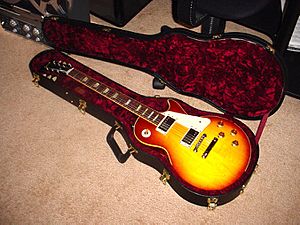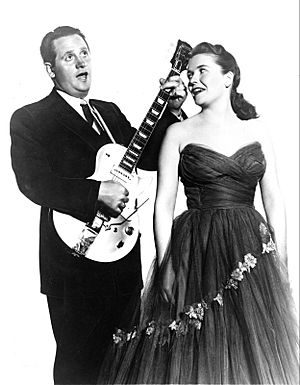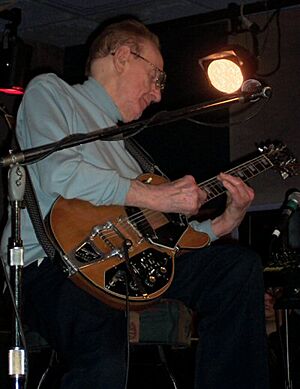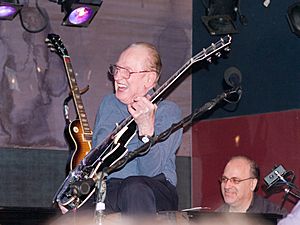Les Paul facts for kids
Quick facts for kids
Les Paul
|
|
|---|---|
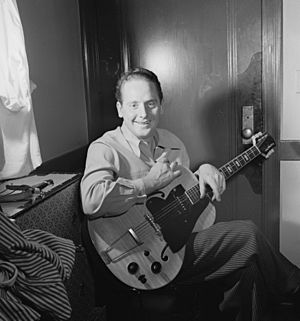
Paul, c. January 1947 (photograph
by William P. Gottlieb) |
|
| Background information | |
| Birth name | Lester William Polsfuss |
| Born | June 9, 1915 Waukesha, Wisconsin, U.S. |
| Died | August 12, 2009 (aged 94) White Plains, New York U.S. |
| Genres | |
| Occupation(s) |
|
| Instruments |
|
| Years active | 1928–2009 |
| Labels | RCA Records |
| Associated acts | Mary Ford |
Lester William Polsfuss (born June 9, 1915 – died August 12, 2009), known as Les Paul, was an American musician and inventor. He played jazz, country, and blues guitar. Les Paul was a pioneer of the solid-body electric guitar. His early guitar design, called "The Log", inspired the famous Gibson Les Paul guitar.
Paul taught himself how to play the guitar. While he is famous for jazz and pop music, he started his career in country music. In the 1950s, he and his wife, singer and guitarist Mary Ford, sold millions of records.
Les Paul also created many new ways to record music. He was one of the first to use overdubbing (layering sounds). He also experimented with delay effects, phasing, and multitrack recording. His unique guitar playing style inspired many guitarists. He is honored in the Rock and Roll Hall of Fame and the National Inventors Hall of Fame.
Contents
Early Life and Musical Beginnings
Les Paul was born Lester William Polsfuss in Waukesha, Wisconsin. His parents were George and Evelyn Polsfuss. They were of German background. His parents divorced when he was young. His mother later shortened their family name to Polfus. Before using the name Les Paul, he performed as Red Hot Red and Rhubarb Red.
At age eight, Paul started playing the harmonica. He then learned piano before switching to the guitar. He even invented a special holder for his harmonica. This allowed him to play both the harmonica and guitar at the same time. This design is still used today.
By age thirteen, Paul was a semi-professional country music performer. He sang, played guitar, and harmonica. He started experimenting with sound early on. To make his acoustic guitar louder, he attached a phonograph needle to it. He then connected it to a radio speaker. As a teenager, he also experimented with making notes last longer (sustain). He used a piece of train track for this. At seventeen, he joined Sunny Joe Wolverton's Radio Band in St. Louis, Missouri.
Career Highlights
Early Music Career
Paul moved to Chicago in 1934. He continued to play country music on the radio. He also performed at the 1934 Chicago World's Fair. In Chicago, he learned jazz from famous musicians. He played country music as Rhubarb Red during the day. At night, he was Les Paul, playing jazz. He met pianist Art Tatum, who inspired him to keep playing the guitar. His first two records came out in 1936 under the name "Rhubarb Red". He also played with other bands for Decca. During this time, he started using his stage name, Les Paul.
Paul loved the music of Django Reinhardt, a famous guitarist. After World War II, Paul became friends with Reinhardt. When Reinhardt died in 1953, Paul helped pay for his funeral. One of Paul's favorite guitars was a Selmer acoustic guitar. Reinhardt's widow gave it to him.
In 1937, Paul formed a trio. It included Jim Atkins (guitar) and Ernie "Darius" Newton (bass/percussion). They moved to New York in 1938. They got a spot on Fred Waring's radio show. Jim Atkins' younger half-brother, Chet Atkins, later said Les Paul gave Jim an expensive Gibson guitar. It was Chet's first professional guitar.
In 1941, Paul had a serious accident in his basement. He almost died from electrocution. He spent two years recovering in Chicago. There, he worked as a music director for radio stations. In 1943, he moved to Hollywood and formed a new trio.
He joined the U.S. Army in 1943. He performed for the Armed Forces Radio Network. He played with stars like Bing Crosby and the Andrews Sisters. Paul also played at the first Jazz at the Philharmonic concert in Los Angeles in 1944.
Paul's trio appeared on Bing Crosby's radio show. Crosby supported Paul's recordings. They recorded "It's Been a Long, Long Time" together, which was a number one hit in 1945. Paul recorded several albums for Decca in the 1940s. The Andrews Sisters hired his trio for their tour in 1946. They loved his unique playing style.
In January 1948, Paul was in a bad car accident. He shattered his right arm and elbow. Doctors told him they couldn't fix his elbow. They suggested cutting off his arm. Paul was flown to Los Angeles. His arm was set at an angle, just under 90 degrees. This allowed him to still hold and play the guitar. It took him almost a year and a half to recover.
Guitar Innovations
In 1940, Les Paul continued his experiments with guitar design. He built a special solid-body electric guitar called "The Log". It was made from a 4x4 piece of wood. It had a bridge, neck, strings, and a homemade pickup. Paul built "The Log" at the Epiphone guitar factory after hours. It was one of the first solid-body electric guitars. To make it look like a regular guitar, he attached the sides of a hollow-body guitar to "The Log". This helped solve two big problems: feedback (unwanted noise) and sustain (how long notes ring out). Paul kept improving these guitars and used them in his recordings.
Paul shared his idea for a solid-body electric guitar with the Gibson Guitar Corporation in 1941. But Gibson wasn't interested at first. That changed when Fender started selling its solid-body guitars in 1950.
Gibson's Ted McCarty designed the famous Gibson Les Paul guitar. It was based on Paul's ideas. Gibson made a deal with Les Paul, paying him for each guitar sold. The guitar went on sale in 1952. Paul continued to suggest design improvements.
By 1960, sales of the original Les Paul model dropped. Gibson introduced a new model, now called the SG. It still had the Les Paul name. But Paul didn't like the new design. He also had problems with the guitar's strength. This, along with his divorce from Mary Ford, led him to stop endorsing Gibson guitars from 1964 to 1966.
Paul kept suggesting new technical ideas. In 1962, he got a patent for a pickup built into the guitar's bridge. In the mid-1940s, he made an aluminum guitar. It had no headstock, and the tuning parts were below the bridge. This made it the first "headless" guitar. But it was too sensitive to heat from stage lights and wouldn't stay in tune. Still, he used it for some hit recordings. Other inventors later developed this style.
Today, a more affordable version of the Les Paul guitar is made by Gibson's Epiphone brand.
Multitrack Recording Innovations
Les Paul first experimented with layering sounds when he was a child. He punched holes in his mother's player piano rolls to create new sounds. In 1946, his mother heard a song on the radio and thought it was him. It was actually George Barnes. This made Paul want to create his own unique "New Sound". He spent two years in his Hollywood garage studio working on it. In 1948, his "New Sound" amazed the music world.
Paul recorded several songs with Bing Crosby. Their song "It's Been a Long, Long Time" was a number one hit in 1945.
Bing Crosby suggested Paul build his own recording studio. Paul set up a studio in his garage in Hollywood. Many singers and musicians came to him for his expertise. He experimented with microphone placement, recording speed, and overdubbing. His methods made multitrack recordings sound clearer than ever before. People started to see his recording techniques as important as the instruments themselves.
Capitol Records released "Lover (When You're Near Me)". On this song, Paul played eight different guitar parts. Some parts were recorded at half-speed, making them sound "double-fast" when played back normally. This was his first time using multitracking in a recording. His early multitrack songs, like "Lover" and "Brazil", were made using acetate discs. He would record one part, then play along with it and record both onto a new disk. He kept doing this until he got the sound he wanted. He threw away about 500 disks to get it right!
As a teen, he built a disc-cutter using parts from his father's car repair shop. Years later, in his Hollywood garage, he used this setup to record parts at different speeds and with delay. This created his unique sound with echoes and guitar riffs that sounded like birds.
In 1949, Bing Crosby gave Paul one of the first Ampex Model 200A reel-to-reel tape recorders. Paul invented "sound on sound" recording with this machine. He added an extra playback head before the main recording heads. This let him play along with a track he had already recorded. Both sounds were then mixed onto a new track. The Ampex machine only had one track. So, the original recording was replaced by the new, mixed one. He later improved this by using two tape machines. One played the original, and the second recorded the combined track. This way, the original recording was saved.
In 1952, Paul invented the flange effect. This makes a sound phase in and out, creating a unique harmonic tone. You can hear the first example of this on his song "Mammy's Boogie".
Paul was inspired by film recordings to stack eight tape recorders. He worked with Ross Snyder to design the first eight-track recording deck for his home studio. Rein Narma built a custom 8-channel mixing console for him. This mixing board had equalization and vibrato effects. Paul called the recorder "The Octopus" and the mixing console "The Monster". The name "octopus" came from comedian W. C. Fields. Fields was the first person to hear Paul's multi-tracked guitar experiments. He told Paul, "My boy, you sound like an octopus!"
Les Paul and Mary Ford
In 1945, Paul met singer Iris Colleen Summers. They started working together on Paul's radio show. Paul later suggested her stage name, Mary Ford. They got married in Milwaukee in 1949.
They had many hit songs together. These included "How High the Moon", "Bye Bye Blues", "The World Is Waiting for the Sunrise", and "Vaya con Dios". They recorded these songs using multiple tracks. Ford would harmonize with herself, and Paul would play many layers of guitars.
They used a recording technique called close miking. This means the microphone was very close to the singer's mouth. This made their sound more personal and less echoey. It also made their singing style different from older, unamplified theater styles.
They also performed funny routines where Mary would copy whatever Les improvised.
Radio and Television Shows
Paul hosted a 15-minute radio show called The Les Paul Show on NBC Radio in 1950. It featured his trio, which included himself, Mary Ford, and Eddie Stapleton. The show was recorded from their home. Les and Mary would share gentle jokes between songs. They played their hit songs and new versions of jazz and pop tunes. Many of these shows still exist today.
Paul could take his magnetic tape recording equipment on tour. This allowed him to record episodes for his radio show from hotel rooms.
A few years later, the show moved to television. It had the same format but without the trio. It was called Les Paul & Mary Ford at Home. "Vaya Con Dios" was its theme song. The show aired on NBC television from 1954 to 1955. It was then shown in syndication until 1960. This five-minute show played one or two songs. It aired five times a day, five days a week. It was often used as a short break in programming. Paul created the entire show himself, including audio and video. He worked on restoring the original recordings until he passed away.
On his radio shows, Paul talked about a made-up device called the "Les Paulverizer". He said it could multiply any sound, like a guitar or a voice. This was his way of explaining how his one guitar could sound like many guitars. It even became part of their comedy. Mary Ford would joke about multiplying herself and her vacuum cleaner to finish housework faster. Later, Paul built a real Les Paulverizer for his guitar. This invention let him play pre-recorded layers of songs during live shows. He could then sound just like his recordings on stage.
Later Career and Legacy
In 1965, Paul mostly retired from performing. But he still went to his studio sometimes. He and Mary Ford divorced at the end of 1964. She was tired of touring. One of Paul's well-known recordings from this time was Les Paul Now (1968). On this album, he updated some of his older hits. He also recorded two albums with guitar legend Chet Atkins: Chester and Lester (1976) and Guitar Monsters (1978). These albums mixed jazz and country music.
In 1969, Paul produced an album called Poe Through the Glass Prism. It featured songs based on Edgar Allan Poe's writings.
As he got older, Paul played at slower speeds. He used a large pick that was easier to hold because of his arthritis. In 2006, at age 90, he won two Grammy Awards for his album Les Paul & Friends: American Made World Played. He also performed every Monday night at Manhattan's Iridium Jazz Club.
Personal Life
Les Paul married Virginia Webb in 1937. They had two sons, Les Paul Jr. (Rusty) and Gene.
After divorcing Virginia in 1949, Paul married Mary Ford. The parents of guitarist Steve Miller were their best man and matron of honor. Paul was Miller's godfather and his first guitar teacher. Paul and Ford had a daughter who died shortly after birth in 1954. They adopted a girl, Colleen, in 1958, and had a son, Robert (Bobby), in 1959. Paul and Ford divorced in December 1964.
Paul and Ford had a home in Mahwah, New Jersey. Mary Ford lived there until she died in 1977.
In 1995, Paul started the Les Paul Foundation. It was meant to begin its work after his death. The foundation helps inspire creative thinking. It shares Les Paul's legacy by supporting music education, recording, innovation, and medical research related to hearing.
Death
Les Paul died on August 12, 2009, from complications of pneumonia. He passed away at White Plains Hospital in White Plains, New York. Many musicians shared their thoughts after his death. Slash called him "vibrant and full of positive energy". The Edge said, "His legacy as a musician and inventor will live on." On August 21, 2009, he was buried in Prairie Home Cemetery in Waukesha, Wisconsin.
Awards and Honors
Les Paul received many awards. In 2007, U.S. President George W. Bush gave him the National Medal of Arts.
Paul was inducted into the National Inventors Hall of Fame in 2005. This was for his work on the solid-body electric guitar. In 1988, guitarist Jeff Beck inducted him into the Rock and Roll Hall of Fame. Paul was also inducted into the Songwriters Hall of Fame (2005) and the Big Band & Jazz Hall of Fame (1990).
Two of his songs, "How High the Moon" and "Vaya Con Dios", are in the Grammy Hall of Fame. In 1976, he and Chet Atkins won a Grammy for Best Country Instrumental. In 2005, he won two more Grammys for "Caravan" and "69 Freedom Special."
In 1983, Paul received a special Grammy for his lifetime achievements. In 2001, he got the Special Merit/Technical Grammy Award. This award honors people who set high standards in using audio technology. Other winners include Thomas Alva Edison and Leo Fender. In 2004, he received an Emmy Lifetime Achievement Award in Engineering.
In 1960, he and Mary Ford received a star on the Hollywood Walk of Fame.
In 2009, Time magazine named Paul one of the top ten electric guitarists ever. Two years later, Rolling Stone magazine named him the eighteenth greatest guitarist of all time. His name was also added to the Nashville Walk of Fame.
Concerts and Exhibitions
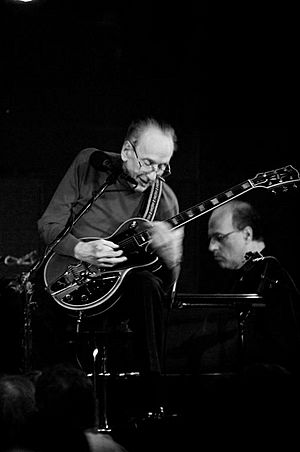
In July 2005, a concert was held at Carnegie Hall in New York City to celebrate Les Paul's 90th birthday. Musicians like Steve Miller and Peter Frampton performed. Paul received a special guitar from the Gibson Guitar Corporation. Three years later, he received the Rock and Roll Hall of Fame's American Music Masters Award. On June 9, 2015, a year-long celebration for Paul's 100th birthday began in Times Square. It included performances and an exhibition of his items.
In 2007, a film about Paul called Les Paul Chasing Sound aired on public television. It included interviews with Paul, performances, and comments from other musicians.
In June 2008, an exhibit about Paul's life opened at Discovery World in Milwaukee. Paul played a concert there for the opening. His hometown of Waukesha, Wisconsin, opened a permanent exhibit called "The Les Paul Experience" in 2013. It features items from the Les Paul Foundation.
A permanent Les Paul exhibit is also at the Mahwah Historical Museum. Other museums with Les Paul exhibits include the Museum of Making Music and the Grammy Museum.
In 2009, the concert film Les Paul Live in New York was shown on public television. It featured Paul performing on his 90th birthday.
Discography
Albums
- The New Sound (Capitol, 1950)
- Les Paul's New Sound, Vol. 2 (Capitol, 1951)
- Bye Bye Blues! (Capitol, 1952)
- The Hit Makers! (Capitol, 1953)
- Les and Mary (Capitol, 1955)
- Songs of Today (Capitol, 1956)
- Time to Dream (Capitol, 1957)
- The Hits of Les and Mary (Capitol, 1960)
- Les Paul and Mary Ford (Capitol, 1961)
- Bouquet of Roses (Columbia, 1962)
- Warm and Wonderful (Columbia, 1962)
- Les Paul Now (Decca, 1968)
- The World Is Still Waiting For The Sunrise (Capitol, 1974)
- Chester and Lester with Chet Atkins (RCA Victor, 1976)
- Guitar Monsters with Chet Atkins (RCA Victor, 1978)
- Early Les Paul (Capitol, 1982)
- Feed Back 1944–1955 (Circle, 1986)
- The Best of the Capitol Masters: Selections from "The Legend and the Legacy" Box Set (Capitol, 1992)
- American Made World Played (Capitol, 2005)
- A Tribute to a Legend (Immergent, 2008)
Hit Singles (Selected)
- "It's Been a Long, Long Time" (with Bing Crosby) (1945) - #1 hit
- "Rumors Are Flying" (with The Andrews Sisters) (1946)
- "Lover" (1948)
- "Brazil" (1948)
- "Nola" (1950)
- "Tennessee Waltz" (with Mary Ford) (1950/1951)
- "Mockin' Bird Hill" (with Mary Ford) (1951) - #1 hit
- "How High the Moon" (with Mary Ford) (1951) - #1 hit
- "The World Is Waiting for the Sunrise" (with Mary Ford) (1951)
- "Tiger Rag" (with Mary Ford) (1952)
- "Meet Mister Callaghan" (1952)
- "Bye Bye Blues" (with Mary Ford) (1953)
- "Vaya Con Dios" (with Mary Ford) (1953) - #1 hit
- "Hummingbird" (with Mary Ford) (1955)
- "Love Sneakin' Up on You" (with Joss Stone & Sting) (2005)
Compositions
Les Paul wrote many songs. Some of his compositions include: "Song in Blue", "Cryin'", "Hip-Billy Boogie", "Suspicion", "Mandolino", "Magic Melody", "Don'cha Hear Them Bells", "The Kangaroo", "Big-Eyed Gal", "Deep in the Blues", "All I Need is You", "Take a Warning", "Mammy's Boogie", "Up And At 'Em", "Pacific Breeze", "Golden Sands", "Hawaiian Charms", "Mountain Railroad", "Move Along, Baby (Don't Waste My Time)", "Dry My Tears", "I Don't Want You No More", "Doing the Town", "Les' Blues", "No Strings Attached", "Subterfuge", "Lament For Strings", "Five Alarm Fire", "You Can't Be Fit as a Fiddle (When You're Tight as a Drum)", and "Walkin' and Whistlin' Blues".
See also
 In Spanish: Les Paul para niños
In Spanish: Les Paul para niños
- Ampex
- Discovery World
- Gibson Les Paul
- Gibson SG
- List of Rock and Roll Hall of Fame inductees
- Mary Ford
- Les Paul and Mary Ford



